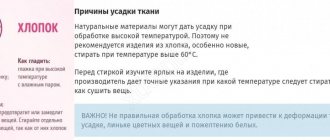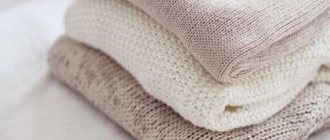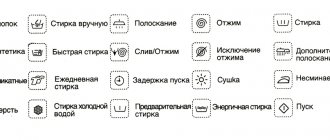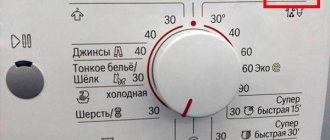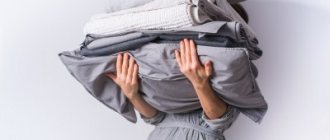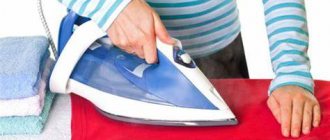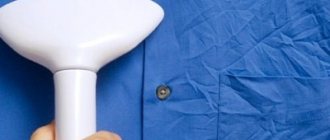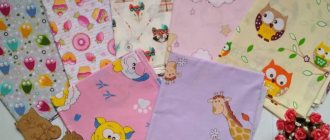Home / Articles / At what temperature to iron cotton, wool, silk and other fabrics
22 Feb 2018
Category: Articles
No comments
In order for clothes to retain their original appearance for a long time, they must not only be properly washed and dried, but also ironed. In ancient times, housewives smoothed things out using a stone or roller heated in a flame, and there was practically no risk of ruining the fabric. Then irons appeared, heated with coal, which took root in everyday life for a long time. And only many years later the first electric iron was invented - a very convenient device that requires great care and precision in handling.
Read in this article:
- What you need to know about ironing temperature
- Icons on labels - what do they mean?
- Wool ironing temperature
- Ironing silk items
- Ironing linen and cotton
- Tips for ironing synthetics
- What items cannot be ironed?
How to iron things depending on the composition of the fabrics
Depending on their composition, different types of fabrics require different ironing modes:
If cotton and linen can be ironed at maximum temperatures using large amounts of steam, then you need to be very careful with chiffon. Steam and spray mist can stain delicate fabrics. Natural silk is very capricious. Silk products are not moistened, but ironed in an undried state from the inside out through gauze. The same goes for wool. If possible, products made from it are not ironed, but hung on hangers over steam.
Satin is ironed with extreme care when wet. The iron is not held in one place for more than 2 seconds
Use an iron and iron in the “silk” mode. Viscose is a capricious fabric. It should be ironed as quickly as possible and through gauze, since it tends to lose color and texture if the iron is held in one place for more than a few seconds. Products made from velor, as a rule, are not ironed, since velor does not wrinkle. If, however, folds have formed, the product is steamed without touching the iron, or suspended above the steam. Faux fur - ironed from the front side through damp gauze in the direction of the pile. Suede products should not be ironed. Use either a steamer or keep it over steam until the wrinkles disappear completely. The lace is ironed from the inside out through an ironing iron on a soft backing.
Video: look at the fabric, then iron it
The main parameters for ironing various types of fabrics are shown in the table below.
Table: recommended parameters for wet-heat treatment of various materials
Material Steam quantity Steam quality Temperature, °C Instructions Cotton Medium Wet 180–220 Need pressure Cotton velor Average Less damp 180–220 Avoid pressure Linen Much Wet 215–230 Cotton + linen Much Wet 180–220 Wool Much Wet 160–170 Silk Very little Less wet 140–165 Without water Viscose Medium Wet 150–180 Acetate Little Dry 180–190 Be careful, las! Fine Jersey Few Dry 140–150 Beware, lassies! Wool Jersey Light Dry 140–150 Polyester (Polyester) Very Light Very Dry 160–200 Polyamide Light Dry 150–160 Polyurethane (Elastane) Very Light Dry 150–180 Polyacrylonitrile (PAN) Very Light Dry 150–180 Raincoat Light Very Very Dry 180 –220 Cotton + synthetics Average Dry 160–170 Wool + PAN Average Little moisture 160–180 Cotton corduroy Average Less wet 180–190 Rib movement Knitwear Average Wet 150–180 Without distortion
Everyone can easily cope with routine ironing. You just need to take into account a few simple rules, then the process will go faster and with pleasure.
What mode should you iron on?
The wash label fades, becomes dull, and may not exist at all. It’s easy to understand if you know the composition of the material
Attention is paid to ironing natural silk and woolen items. The care regimen for natural and synthetic fabrics differs
Ironing silk
Capricious silk is ironed, following the rules:
- The device is set to “silk” mode or the lowest heating setting. Turn the material over to the “left” side. They run the sole over a small area to check whether an accident will occur. Having obtained a good result, iron the item completely, without staying in one place for too long.
- Turning inside out is necessary so as not to spoil the coating.
- Place a gauze rag between the fabric and the sole. Check that the iron does not leave streaks or stains.
- It is prohibited to wet silk before ironing. Manufacturers indicate that the item should not be steamed. A silk item will turn into a hard and dull rag. The material is ironed only when dry.
- Place a towel slightly moistened with water on a fabric that is too dry and continue to smooth it.
Cotton
Cotton is a natural fabric. It is easier to iron when slightly damp. The dried item is first treated with water from a spray bottle or a spray or steamer mode is used.
A good way is to take a thin gauze rag and place it on top of the cotton material. Iron over it.
Trouble often happens - dirt under the influence of elevated temperatures is firmly sealed into the item, so cotton material must be washed well.
Linen
New linen is usually stiff and difficult to iron. Natural fabric will change after a couple of washes, but the first time you will have to try.
- The item will iron better if you do not let it dry completely. Lightly wet dry material before use.
- The device must be well warmed up.
- Turning the fabric inside out will help prevent shine.
- Linen material cannot be smoothed to a smooth surface without wrinkles and errors.
- Spraying the cloth with water will make your work easier.
- Small details - rhinestones, beads, buttons - are ironed through gauze material.
Synthetics
Artificial materials can be ironed at a temperature of 120-130° C.
- Polyester is ironed through a thin natural rag, moistened and well wrung out.
- Outerwear is ironed from the inside. To avoid burning the lining fabric, use a thin cotton towel for ironing. The front side is worked through a cotton covering.
- Hard-to-reach places (collars, fasteners, zippers, petticoats) are treated at elevated temperatures.
- You cannot press the item with force or iron one area for a long time, even if it is very wrinkled.
- Immediately after processing, the material is left to cool; folds and wrinkled areas will gradually disappear.
A warm sole will not cope with synthetic material. When processing, make sure that the fabric does not deteriorate and that stains and smudges do not form on it. Too high a temperature will render the item unusable and may even melt the fibers.
Without steamer
If you don’t have a steamer or iron at home, or, for example, there’s a power outage, you can straighten the curtains using steam. You need to get steam by simply boiling water. For this method you will need a kettle (gas or electric) or a small saucepan filled with water. Bring the water to a boil and continue boiling for another 5 minutes. Then take a container of boiling water and bring it to the hanging curtain. Direct the steam so that it hits the fabric. Use your hands to straighten the fabric and remove creases. The material smooths out before our eyes and has a neat appearance. For better results, you can slightly wet the curtains with a clean damp cloth; they will smooth out much better and faster.
How many degrees does the iron heat up to?
For fabrics that are most difficult to iron, it is necessary to use a maximum iron heating temperature in degrees equal to 205˚C. In this case, the heating rate will depend on the type of material from which the sole of the iron is made, and the power of the electrical appliance.
Heating rate depending on sole material
The sole is made from:
- Aluminum. Heating occurs very quickly, and cooling also occurs, but the material is short-lived. Hard elements on clothing can leave scratches in which burnt-on fabric particles become embedded.
- Of stainless steel. It heats up quickly, glides well over the surface, and is durable. The disadvantage is the heavy weight of the device.
- Ceramics. This coating is applied to a metal base. It glides perfectly, allows you to iron fabric in hard-to-reach places, and does not catch clothes. Heating and cooling take longer. Ceramic retains heat, so even when turned off, the iron remains on for 8-10 minutes. stays hot. The disadvantage is the fragility of ceramics, susceptibility to chips and damage. To extend service life, manufacturers use cermets.
- Teflon - reliably protects clothes from burning, but does not last long. The Teflon surface does not glide well over fabric, making ironing difficult.
- Sapphire is a specially developed alloy that gives the sole extra strength. Conducts heat well.
- Titanium is rarely used in the production of household irons. The metal will heat up quickly and take a long time to cool down. The surface strength is not inferior to steel.
Maximum temperatures in different models may vary, so before choosing a mode, you should read the instructions.
If the iron has only one heating mode, there is no spray and steam function, the temperature of the iron sole will be 115˚C (±10).
Irons with a drip system are slightly hotter - about 155˚C.
Electrical appliances with the possibility of steam processing reach temperatures of 175-205 ˚C.
Influence of electrical appliance power
The speed of heating the surface, the possibility of supplying a “cloud” of steam, and the speed of cooling of the sole directly during ironing depend on the power of the iron.
In household models, the power ranges from 800 to 2200 W. Models that are not equipped with a thermostat and a humidifier have a lower power - within 400 W. Ironing them is much more difficult; they heat up more slowly and cool quickly.
Advice! An iron with a power of 1500 to 2200 W is suitable for household use. For those who like to iron a large number of items with maximum comfort, models with a power close to 2700-2800 W are suitable, but you should make sure that the wiring can withstand this voltage and do not turn on several electrical appliances at the same time.
Professional ironing for many hours, for example, in a laundry or dry cleaning, will require the purchase of a more expensive and powerful device - from 2800 W. Heating in such models occurs as quickly as possible, and the steam boost is extremely powerful (about 230 g/min).
Minimum iron temperature
To select the lowest temperature, you must select the “silk” ironing mode (one point). The minimum ironing temperature is 75˚C.
In irons without a thermostat, the heating temperature is about 115 °C. Since it is impossible to select a delicate treatment mode for the product, you should start ironing from the wrong side, moistening the fabric.
When straightening an item that cannot be ironed, even the mode set to one point can ruin it. To safely process fabric you must:
- moisten it with a spray bottle and hang it for leveling;
- apply steam;
- iron, placing the item between two layers of fabric: dry on the bottom, wet on top.
Advice! Before steam treatment, you need to make sure that no rust particles or drops of water come out of the nozzles, which can leave streaks. A removable attachment on the soleplate of the iron will help prevent contamination.
Steam temperature in the iron
Steam helps to moisten the item and makes it much easier to straighten the fabric, but for particularly wrinkled areas, a “steam boost” is used. The feed intensity depends on the power of the iron.
In household models, the steam force is about 20-25 g/min. More professional equipment allows you to use steam supplied at an intensity of 160 g/min. In this case, the steam temperature reaches 160-210 ˚С depending on the characteristics of the model.
How to iron linen and home textiles
It is better to iron bamboo, linen and cotton items a little damp. When there are decorative inserts, use gauze. Here are some useful tips:
- The sheets have elastic. The linen is folded in half, then in half again, then ironed. It is necessary to ensure that there are no folds or creases on the product. You can iron in another way: start from the center, gradually turning the fabric itself, moving in a circle. But it’s easiest to iron it directly stretched on the mattress.
- Duvet covers. First, all buttons and zippers are fastened, the product is straightened and ironed on one side. Then fold it in half so that the wrinkled side remains on the outside and iron it. And so on until the duvet cover takes the desired size for storage.
- Silk bedding. Many people do not know how to iron silk bed linen: they iron it half-dry, only from the inside out.
- Tablecloths. If they are trimmed, ironing starts from the edge and ends in the middle. It is better to fold a regular tablecloth 4 times and iron it one by one on all sides.
- Curtains. The easiest way to iron them is by vertical steaming using a steam generator. If there is none, chairs are placed around the ironing board to lay the ironed fabric. Iron the curtain from above, moving downwards.
How to tidy up cotton and linen items
Almost no one has a question at what temperature to iron cotton or linen: you need to set the maximum value on the relay and you can start working. But the fabric, unassuming at first glance, is quite difficult to smooth out, always remaining slightly wrinkled. How to avoid this effect?
It is important to know: steaming is the only way to properly iron a cotton or linen product.
It is equally important to set the temperature correctly:
- 100% cotton should be ironed at a temperature of 150 to 200 degrees, with powerful steaming or spraying water with a spray bottle;
- cotton is diluted with polyester - in this case, the ironing temperature is no more than 110 degrees, the amount of steam and water is limited to a minimum;
- The material contains cotton and linen threads - the relay is set to 180-200 degrees, and the item is generously moistened with water.
Linen can only be exposed to very high temperatures - up to 230 degrees. The product is ironed from the front side, so you must be careful not to burn the item.
Basic ironing modes
Even novice housewives know that the iron can be used in several modes. But not everyone understands the intricacies of the differences between different ironing methods. But the result largely depends on the right choice!
There are three main modes of using the iron:
- The dry regime is the most ancient. It was used in the very first irons, in which heating was carried out by the heat of coals embedded in the body. The smoothing effect in this mode is provided by the weight of the iron, the sliding of its sole and the surface temperature. The main disadvantage of the regime is the high risk of damage to things. If you hold the iron in one place, a charred spot will appear.
- Ironing dampened fabric. In this case, the product to be smoothed is wetted using a spray bottle or wet gauze. Moisture makes fabric fibers softer, reduces friction and makes ironing easier. The disadvantage of this method is the need to manipulate additional devices. It takes experience to learn how to properly moisturize your clothes.
- Steaming mode. In it, the iron creates a stream of steam, which is directed through special holes on the sole onto the item. Steam allows you to effectively and quickly deal with wrinkles on fabric. However, the built-in steamer complicated the design of the iron, which means it increased the price of the device and made it more difficult to operate and care for.
The preference for one mode or another should not negatively affect the service life of the iron
But it is important to understand in what cases each ironing method is used, otherwise more labor will be required. The risk of clothing damage if ironing is done incorrectly also increases.
How to find out the temperature of the iron
The easiest way to find out the temperature of the iron is by points. However, it happens that during delicate ironing the item “burns”, or at maximum mode the sole remains not hot. Perhaps the reason is a broken thermostat. You can check the heating temperature of the iron by using high-temperature thermometers. It is enough to purchase a digital or mechanical device that allows you to measure temperatures up to 300 ° C, because it does not go higher in irons. The cost of meters is from 200 rubles. More expensive are infrared pyrometers (from 1000 rubles), which allow you to measure temperature without direct contact with the object. Such a device is useful for measuring t of liquids, food, electric heating devices and other objects.
There are also “folk” verification methods:
- Spray the iron and wait until it sizzles. This means that the temperature is above 100˚C.
- Iron natural wool. If the villi have become dry and brittle, the temperature is close to 105 °C, and if an unpleasant smell of burnt hair appears, the heating has reached 120 °C.
In order not to risk your favorite things, it is important to know exactly what temperature the soleplate of the iron has reached. It is better to experiment and purchase a device with a thermostat, follow the instructions for use, and study the labels on clothes before ironing. If you suspect a breakdown, measure t using a special thermometer and repair the electrical appliance using the warranty card.
Important Features
To make your work easier, you need to take into account the characteristics of the material:
- Cotton fabric must be ironed on both sides, otherwise it will still look untidy.
- It is advisable not to leave silk bedding until completely dry, but to begin ironing it while still damp. Iron only on the reverse side, do not splash water on it.
- It is harmful to use additional moisture when processing satin linen. It must be laid out on the ironing board with the wrong side up and the “dry” method used to avoid water stains.
- It is better to go over the chintz with an iron from the front side, not forgetting to wet the surface with a spray bottle.
- To quickly iron synthetic fabric, use gauze or a thin, clean cloth. The main product must first be completely dried.
- Dark colored material must be ironed correctly from the wrong side, otherwise there is a high risk of shiny marks appearing on the fabric.
- If there are decorative elements on the linen in the form of applique or embroidery, you can treat them with a steamer. Iron only from the inside out, placing the decor on a soft terry towel.
Features of heating irons
Every housewife knows that a good iron should have the following qualities:
- uniform heating of the sole;
- moderate weight;
- smooth glide.
It is very important that the set temperature for ironing fabrics on the device is maintained evenly over the entire surface of the sole. This indicator largely depends on the material of manufacture. For these purposes the following are used:
- ceramics;
- aluminum;
- steel;
- cast iron.
Ceramics have proven themselves best. The temperature maximum occurs in the center of the sole, gradually decreasing towards the edge. The approximate difference between the center and the outskirts is about 10 °C.
Most devices have in their design such components as a heating element, thermostat, signal lamp and steam function.
Each iron operating mode has 3 temperature values: nominal, maximum and minimum. The data is presented in the table.
Table 1. Iron sole temperature values for different modes
| • | •• | ••• | |
| Maximum value, °С | 115 | 155 | 205 |
| Minimum, °С | 75 | 105 | 145 |
| Nominal, °С | 95 | 130 | 175 |
Ironing complexly shaped clothes
Most of the methods described above are suitable for straightening simple items of clothing, such as a T-shirt. It is much harder to tidy up a shirt or pleated skirt.
The following ironing methods are most suitable for such products:
- Its complete absence. Things are completely wetted and carefully secured on hangers, tucks and other devices to avoid creases and bends. In this position, the shirt or blouse is left until completely dry.
- Ironing with a hot lamp. This method is suitable for extreme situations when it is urgent to get rid of wrinkles. Take a light bulb and carefully wipe it from dust and dirt, then screw it into the lamp. It is advisable to first remove the lampshade from it. Plug it in and wait for the light bulb to warm up well. Apply this “iron” over the surface of the product and remove all irregularities.
The use of the last available means is associated with some danger to humans. It is necessary to ensure that the lamp does not overheat too much, as bright scorch marks will appear on the product. Clothes must be completely dry and the lamp must be in good condition.
Selecting the correct temperature for the washing mode
It is not enough to choose the right program for the fabric and type of product; you also need to understand which temperature regime is most optimal for a particular situation:
- cotton - temperature 90-95 degrees, spin set to maximum speed;
- manual mode - delicate expensive fabric is processed, cleaning occurs at a slow pace, and spinning at low speeds (temperature 30-40 degrees, the icon on the clothes is a hand lowered into the basin);
- fast - ideal cold processing option for small stains, refreshing laundry (working time - 30 minutes, maximum speed is automatically turned on during spinning);
- delicate - similar to the manual mode, but spins, you can wash “capricious” fabrics, sneakers, sneakers, a down jacket, a wadded blanket;
- intensive - the water is heated to 60-95 degrees and intensive washing of heavily dirty items is carried out;
- wool - involves careful washing of woolen items that have the ability to shrink and lose appearance if treated incorrectly (water heating is minimal - 30-40 degrees, no spin);
- normal (everyday) - the best option for washing clothes that are not very dirty, suitable for daily use (cycle duration does not exceed 1 hour, temperature 30 degrees);
- eco - program for economical consumption of water and electricity while maintaining the quality of washing at 30 degrees;
- synthetics - allows you to tidy up synthetic products, it is better to stop the choice at 60 degrees, maximum spin;
- for children - it is supposed to clean heavily soiled items (water is heated to 60-90 degrees, double rinse cycle).
Washing modes and temperatures in different washing machines may differ in names and set of functions. The work can be affected by loading - horizontal or vertical type. For each type of model, a mandatory set of programs is provided.
How to iron properly without water?
First of all, you need to thoroughly drain the water from the tank. It is recommended to do this every time you put the iron away for storage. But before you start dry ironing, it doesn’t hurt to check again if there is any water in the steamer container. If the last few drops cannot be drained in any way, take an unnecessary piece of cloth and iron it in the steam mode until all the water has evaporated.
Before dry ironing, the steam supply is completely closed with the regulator. The item is ironed with quick movements. Usually you have to iron each item on both sides. The ironed item should be left to hang for 30–60 minutes.
We hope that our tips will help you learn how to iron without water correctly. And then your clothes will look perfect. It's worth the effort, isn't it?
How the various functions work
Manufacturers offer various functions of electric irons to ensure ease of ironing. Let's list the main ones:
- automatic shutdown and thermostat;
- steam supply;
- work without regulator;
- anti-drip system;
- steaming in a vertical position.
Let's look at each type separately.
Automatic shutdown and thermostat
Turning off the iron automatically is necessary for fire safety purposes. The design contains a heating element. To prevent fire, the fuse turns off the system if it is:
- 30 seconds in a horizontal position without use;
- about 10 minutes without moving vertically.
The specified parameters are accepted as a safety standard. The basic operating principle of the thermostat is to select the required ironing mode for different types of fabrics. This is a switch that, when turned, selects the desired heating value. When it is reached, the thermostat opens the circuit and the current supply stops. After a few minutes, the process resumes and heating continues.
Steam supply
The steam supply is controlled by two buttons. The first one supplies steam through holes in the sole. When pressed, a portion of water heats up and turns into steam, which is supplied to the base. If you press the second button, water flows to the spout and is sprayed onto the fabric. The function is convenient when processing heavily wrinkled clothes or linen and helps to thoroughly smooth out all the wrinkles. Some models use a steam boost function (increased steam jet), which helps to process thick fabric with folds.
If you use untreated tap water, this leads to the formation of limescale on the surface of the heating elements. Water that is harder in composition quickly reduces the heating effect and can lead to malfunction of the heating elements. It is necessary to monitor the appearance of rust stains and scale particles when using a household appliance. Timely cleaning of heating elements will extend their service life.
Expensive equipment has a filtration system that provides the supply of already purified water. The unit of measurement for steam output is grams per minute. The average continuous feed rate is 10-150 grams/minute. If the fabric is not dried before ironing, 30 grams per 1 minute is enough.
Operation without regulator
Some models use the function of a household appliance with steaming without adjusting the degrees and steam supply. Manufacturers offer users to iron different types of fabrics (silk, cotton, linen, wool, etc.) without thinking about switching ironing modes. Such models are suitable for thin fabrics where there is no need for high heating element values. For dense products, it is better not to use models without temperature control.
Anti-drip system
When steam is generated, there is a possibility of water droplets leaking out of the holes on the sole. The reason for this is inertia - the product must heat up to reach the desired mode. If not all the liquid has been used during ironing, the anti-drip system will not allow the remaining water to flow out of the container after turning off. When the household appliance is plugged in, it prevents excess drops on the fabric.
Steaming in a vertical position
It is very convenient to treat things with hot steam without removing them from the hanger in a vertical position. Note that there is no contact between the sole and the fabric during this process. This function is used to smooth fabric items that cannot be ironed in direct contact with the heating element.
You need to select a suitable model according to its characteristics, taking into account the following rules:
- product cord up to 2 meters, braided, preferably on a rotating hinge;
- you should purchase a household appliance with a wide range of temperature settings;
- The optimal weight is from 1.5 kg; lighter ones will be more difficult to iron out the fabric.
Which iron model should I choose for home use? We tried to answer this question by considering the basic principles of operation and the design of the main modifications.
Temperature conditions for ironing main types of fabrics
Linen
Linen clothing has excellent breathable and thermal conductivity properties. With proper care, it retains its qualities for a long time. To ensure that linen items do not lose their original appearance, they require special care.
How to iron linen correctly:
- The iron temperature when ironing should be 180–200 °C (3 points).
- Turn inside out.
- Provide moisture to clothing. It is better to treat almost immediately after washing or use a spray bottle.
- Intense pressure on the iron.
- Allows you to turn on the steam function.
High-quality ironing of natural linen requires high temperature and humidity. We must not forget that this fabric wrinkles easily, so achieving an ideal result will be quite difficult.
If the material contains additions of other fibers, for example, cotton, then the temperature should not be set above 180 °C.
Particular attention should be paid to the presence of decorative elements. Embroideries and patterns are ironed exclusively from the inside and only through gauze
Direct contact with the base of the device is not allowed.
Very thick clothes are ironed on both sides, but using gauze. For starched items, the temperature should be reduced by about 10–20 °C from the maximum.
Cotton
Clothing made from this material is the most popular. Cotton is a fairly dense fabric that perfectly absorbs moisture and allows air to pass through well. It is used to make bed linen, dresses, shirts and many other things. To properly iron your products, you should follow these recommendations:
- Ironing temperature for cotton is 170–180°C.
- Do not dry completely. Treat wet or using a spray bottle.
- Press firmly on the iron.
- Using wet steam.
In its pure form, cotton is quite difficult to iron. The process requires high temperature and strong pressure. If the item contains the addition of polyester, the heating of the sole must be reduced to 110 °C.
Products without patterns or embroidery are processed from the outside; if there are decorative elements or paints, the clothes must be turned inside out. To obtain maximum effect, you must follow the recommendations indicated on the clothing label.
Silk
Silk is a delicate material that requires careful handling. It dries quickly and has a delicate texture. The fabric is very sensitive to external influences, so you need to know the main rules on how to iron silk.
Rules:
- Silk ironing temperature 60–80 °C (one dot or corresponding inscription on the device panel).
- The use of steam is prohibited. Difficult to remove stains may remain.
- Use a thin cloth, but not gauze. She also leaves streaks on the silk. In this case, a temperature increase of 10–20 is permissible.
- The direction of movement is vertical. Otherwise, the fabric may stretch.
How to iron a silk dress or shirt with a complex cut:
- Hang the product on hangers.
- Cover the top with a thin, slightly damp cloth.
- Heat the device to the temperature indicated on the label. If it is not possible to view the information, then set the mode to 1 point or 1 point on the iron.
- Slowly move the steam at a distance of 4–7 cm from the dress using vertical movements.
The same rules should be followed when working with chiffon and polyester.
Wool
Soft, natural material that is resistant to high temperatures. For safe ironing, you should adhere to the following rules:
- Temperature for ironing wool is 100–120 °C.
- Turn inside out.
- It is better to replace continuous moving of the iron by moving it from place to place. This method will avoid deformation of the fabric.
- Use additional moisture in the form of cotton fabric.
Woolen items are very finicky and do not always tolerate ironing. Read label recommendations carefully. It is better to give preference to vertical steaming for the ironing process.
Viscose
To avoid damage to clothes made from this material, use the following tips:
- Temperature maximum 120 °C.
- It is forbidden to get it wet, otherwise there will be streaks.
- Process only from the inside out.
- Use damp gauze or cotton cloth.
Chintz
Lightweight, thin, highly breathable material. For effective ironing you need:
- Do not increase the temperature above 170 °C.
- Iron from the front side of the product.
- Press firmly on the iron.
- Additional hydration.
Correctly selected ironing temperature is the key to obtaining excellent results.
Decoding the signs on the labels
Each item of clothing contains a special label, which indicates the features of caring for the item. They indicate recommendations for washing, drying and ironing. The most important thing is to be able to decipher them.
Figure 1. Designations of ironing modes.
- Iron. Allows you to iron the product without any special features.
- Iron with 3 points inside. Ironing is allowed at high temperatures up to 200°C. Applicable for linen and cotton.
- Iron inside a circle. Maximum temperature 140 °C. Polyester, polyacrylonitrile fabrics.
- Iron with 2 points. Temperatures up to 150°C. Used for viscose, wool, polyester, polyester, silk.
- Iron with 1 point. Provides ironing at a temperature not exceeding 110°C. Acetate, polyamide, nylon, viscose, nylon.
- The iron is crossed out. Ironing and steaming are prohibited.
- Iron with 1 dot, steam crossed out at the bottom. You can't steam it.
Failure to follow the recommendations on clothing labels can lead to irreversible damage to items.
How to iron tulle without removing it?
- Using an iron. Slightly damp curtains are hung on the curtain rod and allowed to straighten for 1-3 hours. After this time, water is poured into the iron and steam mode is turned on. With the help of the steam released by the iron, all irregularities and creases are ironed out.
- Using a steamer. The fastest way. This machine is ideal for steaming curtains. First, you should pour water into the device, and then leave it for 2-3 minutes to heat up (so that the steam is warm or slightly hot). You have to run the steam generator over the entire area of the curtains. Slowly to smooth out any rough edges.
- With the help of steam. We will need a kettle or saucepan with hot water. The water needs to be boiled and kept on the fire for another 5 minutes. A container of boiled water is brought to the curtain and passed around the entire area.
- Without everything. To iron heavy types of fabric, they are simply hung out and they straighten under their own weight.
Different types of tulle require different ironing conditions. In order not to spoil the appearance of the material, all conditions must be met. If you approach this matter responsibly and with interest, then in the end you will definitely get an excellent result!
At what temperature should you iron wool?
The temperature for ironing wool is 180 degrees. The material needs moisture even more than cotton fabric. The disadvantage of high-quality and expensive woolen items is that they are prone to rapid deformation and loss of shape. Lack of proper care leads to compression or stretching of the material. Therefore, iron them inside out using a cloth soaked in water, preventing the iron from sliding on the fabric.
It is important to know: information on ironing woolen items can be found in the instructions for the iron; the main thing is not to forget that only woven woolen clothing can be ironed. Knitted items should not be ironed as they may stretch and lose their shape.
Ironing silk items
Natural silk fabrics consist of organic components that can deteriorate when exposed to high temperatures, causing the item to deteriorate.
To prevent this from happening, you need to follow the recommendations for ironing natural fabric:
- It is best to iron a silk item when the item is slightly damp. When dry, the material is moistened. Do not spray the material from a spray bottle to prevent stains from appearing on the fabric.
- Modern irons are equipped with a “Silk” mode, which allows for leveling at low temperatures. If the required parameter is not available, the regulator is set to the minimum mode.
- The procedure begins with testing the fiber for sensitivity to certain temperature parameters. To do this, iron a small area of the product from the wrong side.
- It is recommended to iron by turning the item inside out and laying it on a cotton base. Clothes made of thin material (stoles, blouses, shirts, ties and scarves) are smoothed through gauze. The temperature is set slightly higher than usual.
- Dresses, long-sleeved shirts, jackets, suits are steamed vertically at a short distance. Using gauze reduces the risk of item damage.
- It is recommended to use a special coating on the surface of the iron sole to smooth out the silk.
- It is necessary to set all parameters correctly so that no water splashes or steam escapes from the iron during processing.
If the product has a complex cut, it is better to iron it through damp gauze.
Often, a shine may appear on the seams after ironing. This can be corrected by soaking the cloth and steaming it.
The main thing is not to dry the product with a hot iron. Sometimes it is better not to iron artificial material, but simply dry it naturally after washing on a flat surface.
What things should not be ironed?
But not all things can be ironed. Some products and fabrics cannot be ironed or steamed:
What to do with an item that needs ironing if there is a “Do not iron” icon on the label, indicating that ironing is contraindicated for the fabric? Products made from delicate materials are indeed very capricious, and contact with the hot iron platform almost always leads to scorching and deformation. Therefore, it is better to wash such products by turning on the mode for delicate fabrics, and dry them on special forms or hangers.
with non-stick coating with power up to 2150 W costing up to 2000 rubles
As you can see, all the “faces” are recognizable. Well known from the trials of past years. The Tefal iron and the Vitek iron took part in the tests 4 times, the Panasonic iron, the Bosch iron and the Philips iron - for the third time, and the moulinex iron - for the second time.
So we have an amazing opportunity to track how the quality of electric irons changes over time. And what?
Let's start with the bells and whistles. What do brands promise us?
All irons are equipped with a “spray” function, which allows you to precisely direct water to individual folds. Everyone, but not Panasonic, promises a steam boost of varying intensity. But the Panasonic iron is distinguished by the presence of an anti-scale protection system, while the others can only boast of a self-cleaning system. All are equipped with a steam regulator. But if everyone has 3-4 levels, then the vitek iron offers the consumer... as many as 13! With the exception of Tefal, all irons have a vertical steam function. And the pointed “nimble” nose of the Philips iron promises to make the most intimate corners of especially complex-cut items accessible for ironing.
In a word, who is more at the auction of generous promises? And the consumer has no choice but to take the word of the manufacturers and advertising. In the store, no matter how much you twist the iron in your hands, you cannot check most of the promised functions. Rostest checked it. Tests! And what happened?
Average temperature on the surface of the iron sole for different thermostat positions
Temperature, degrees WITH
Iron temperature in degrees or how to properly iron delicate fabrics
An obvious helper for every woman will be the product label, which indicates the temperature for ironing a particular product. But what if you know the material from which the item is made, but there is no label on it. Here you should use practical advice.
What do the icons on the label mean?
The maximum heating temperature of the iron sole is set to 205, and the minimum starts from 110. Knowing these temperature fluctuations and information about the product, it is easy to iron the item correctly.
It’s not enough to have a label on something; it’s important to know what each of these symbols means
| This designation indicates that the product can be ironed. Machine industrial ironing is allowed. |
| This symbol on your product indicates that the item can be ironed with an iron heated to 200 degrees. At this heating temperature, linen and cotton fabrics are ironed. |
| This symbol indicates that the product should not be heated above 140 degrees to avoid damage. If your iron does not have temperature control, then set the slider approximately in the middle. |
| If you notice this icon on the product, then you are holding something made of delicate fabric and should be ironed at a heating temperature not exceeding 130 degrees. |
| This icon, like the previous one, tells us that we have a delicate item in our hands and it requires a special ironing regime. The heating temperature should not exceed 120 degrees. |
| The sign indicates that the item should not be ironed or exposed to steam. |
| This symbol tells us that when ironing a product made from this fabric, you need to turn off the steam function. The fabric is not intended for steaming. |
All these symbols will help the housewife to navigate correctly and iron the item correctly.
The temperature setting for the iron is indicated on the clothing tag.
How to iron wool items
Wool items are delicate fabrics that may shrink or become deformed during washing and ironing, so please read the instructions on your item carefully.
Wool items need constant moisture, so dampen a cotton cloth in clean water and place it on the item and iron it. Do not allow the cloth to dry if your item does not have the desired appearance.
You cannot iron wool directly; the sole of the iron can leave unsightly scorched marks or make a hole, and the wool itself will deteriorate irrevocably.
Wool should be ironed at low temperature
How to iron silk
Simple tips will help you tidy up your silk wardrobe items:
- Silk items are ironed from the reverse side while wet. Do not use an iron to iron silk directly, as this will cause scorch marks.
- Silk items are ironed through gauze or cotton cloth moistened with water.
- In this case, the heating temperature of the base of the device is set to no higher than 160 degrees.
- Silk can be treated with steam, but by setting the steam to minimum power. In this case, the silk will not deteriorate and you will get a beautiful appearance of the product.
Silk ironing is carried out at minimum temperatures
How to iron cotton and linen correctly
When ironing items made from cotton or linen, you should read the label of the item of clothing and make sure that the fabric does not contain foreign impurities. In this case, the label on the product will tell you what temperature to use.
Items made from cotton materials must be ironed at a temperature of 150 - 205 degrees, but if the fabric contains impurities, then see the ironing recommendations on the label.
Be sure to dampen cotton or linen items when ironing, this will help you smooth out creases more easily.
Methods for ironing silk fabrics
Silk should be ironed from the inside out, after placing a thin damp cloth (for example, gauze) on top. The temperature for ironing silk does not exceed 160 degrees. Silk products require special attention when processing with a hot iron:
- a little overkill with the temperature or stopping in one place during the ironing process leads to the formation of scorch marks;
- treatment with steam or water from a spray bottle may cause stains to appear on the product.
Silk is ironed while wet, not allowing the product to dry after washing or after holding it in a wet rag or towel.
Good to know
To iron silk products without leaving stains or marks, you need to know exactly not only the ironing temperature. There are other ways to remove wrinkles without using an iron.
Tulle is also made from various delicate materials, which is why it is so important to know how to iron tulle so as not to spoil anything. Here you will find the most useful tips for yourself - let's study them.
other methods
If for some reason the standard method is not suitable, there are other ironing options.
Aweigh
You can iron the material in another way. To do this, there is no need to remove the fabric, since the ironing process takes place on weight. For this purpose, a small attachment from an ironing board is used to iron sleeves. It is pressed on one side of the fabric, and the iron is moved along the opposite side.
There is another option to get even material by weight. The ironing board is placed right next to the window. The product begins to be processed on one side. When part of the canvas is flat, the curtains are hung on the cornice. Afterwards, the remaining area is placed on the ironing board and ironed further. There is no fear that new creases will appear on the ironed side.
Without iron
If the canvas is small, it can be smoothed without the use of special tools. Something heavy is placed on top of a flat section. Under pressure, the fabric becomes smooth. You can also spray it with water and dry it with a hairdryer.
To remove creases, prepare a solution based on vinegar, water and fabric softener. The components are mixed and the spray bottle is filled with liquid. The components are taken in equal parts. The fabric is sprayed and then allowed to dry completely.
Own weight
One of the easiest ways to straighten curtains and curtains. After washing, they are hung on the ledge. The fabric should be wrung out, but still remain damp. Water should not flow onto the floor. As the fabric dries, it becomes even. The result is ensured due to the material’s own weight.
At what degrees does it boil?
Regardless of the type of appliance used, under normal conditions water boils at the following temperatures (in the most common units of measurement):
| Celsius, 0С | Fahrenheit, 0F | Kelvina, K |
| 100 | 212 | 373,15 |
However, it should be taken into account that in different devices, despite the same boiling point, the time to achieve the process is still different.
For example, the fastest way to boil water is in a modern electric kettle in a heat-protective casing with a powerful 2-3 kW circular heating element. The average time value will be for a regular kettle with the lid closed. A container without a lid will take the longest to achieve results.
Just as the boiling point decreases with decreasing pressure, so with increasing pressure it increases. This principle has found practical application in kitchen appliances - pressure cookers.
The boiling point in them reaches a record for everyday conditions - 120-130C. This allows you to speed up the cooking process (as opposed to mountainous areas - when it boils, but does not cook).
Rules for ironing items made from different fabrics
What material the product is made from is indicated on the inside label. It may also contain information about the permitted temperature for ironing.
- Cotton and linen. The laundry needs to be slightly wet. This will speed up the ironing process and improve the effect. Linen fabric is ironed at 190-230°C, cotton fabric - 160-190°C on the back side to avoid shine.
- Wool. Woolen wardrobe items should be ironed with a gauze on the back side, as they are very stretchy. It is better to just apply the iron or simply steam the item. The ideal temperature is 140-165°C.
- Satin, silk and synthetics. These are delicate materials that cannot withstand high temperatures. If the mode is incorrectly selected, they melt. It is ideal to use lining fabric. It is better to iron silk after moistening it. Just don’t spray it, as water stains will remain on the material. To moisturize, wrap the item in a wet towel for about half an hour. Dark silk is ironed with a dry iron through a thin fabric from the back, and light silk from the face. The temperature varies between 115-140°C. Satin is ironed in much the same way as silk, using the same setting.
- Corduroy and velvet. It is recommended not to iron these materials. Even a light touch with a hot iron will damage the product and crush the material. To straighten the folds, just hold the item of clothing over boiling water or pass along it with a steam generator. There is a more gentle mode: for this you will need a soft lining, which is covered with a towel. A product made of velvet or corduroy is placed on top with the wrong side up. This way you can protect the pile from damage. The material is ironed at low temperature. There is no need to press the iron. If the item still has sunken spots, they can be removed by holding the item face down over hot steam.
- Knitwear. After washing, this material often loses its shape. As a result, it is better to iron knitted items while the back side is still damp. The iron should be applied to the product, and not actively driven. The ironed item does not need to be folded immediately. It’s better to lay it out on the bed and let it dry completely.
- Viscose. Ironed at a temperature of 90-115°C only after the product has completely dried. This should be done from the back to prevent damage to the clothes. Before ironing, the item of clothing is laid out on a board, leveled, and the seams are folded one on top of the other. If you hold the iron in one place, the fabric may lose texture and color.
- Organza and chiffon. Extremely delicate fabrics. Chiffon should be ironed at 60°C. If the iron does not provide such a mode, ironing is carried out through gauze or a clean paper sheet, which prevents heating of the material. Chiffon should not be steamed or sprayed as this will leave noticeable stains on the material. The fabric is moistened with a damp towel. Organza is ironed on thick material through paper or a piece of gauze. The temperature is the same as for chiffon - low to avoid yellow spots.
- Nylon. The material cannot be ironed as it can be damaged at any temperature. To remove wrinkles, the product is moistened in the bathroom and laid out to dry.
- Fabrics with pile. You can use the steamer without pressure. Faux fur with long pile is also steamed, but only through gauze. Then it is combed in the direction of the pile.
Ironing temperature for fabrics – what should you consider?
At what temperature should you iron cotton and other fabrics? Today you can find smart equipment on sale that has many different functions, greatly simplifying the ironing process. You just need to set the desired mode according to the type of fabric and the iron will set the temperature itself. But in any case, you need to be careful - even if you lose vigilance for a short time when ironing clothes, the housewife can ruin a beautiful new thing.
But, in addition to following the instructions included with the iron, you need to pay attention to the ironing marks on the clothes. The characteristics of modern fabrics are almost impossible to determine by touch: without looking at the label, you can confuse cotton with synthetics
Fabric with the addition of synthetic threads, ironed with an iron whose temperature is set to work with a cotton item, will be hopelessly damaged.
